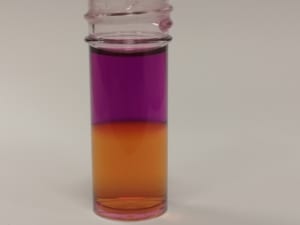
Photo by C. Lloyd at SSERC (Public Domain)
When iodine is added to a pair of immiscible liquids, such as aqueous potassium iodide and cyclohexane, it distributes or partitions itself between the two liquids and an equilibrium is established. The partition of the iodine between the two liquids can be described quantitatively in terms of a partition coefficient.
Interestingly, iodine forms different coloured solutions in aqueous and organic solutions. The photograph on the left shows a purple organic layer over a brown aqueous layer.
By determining the concentration of iodine in samples of each layer, it is possible to work out the partition coefficient.
Partition of iodine – pupil guide



